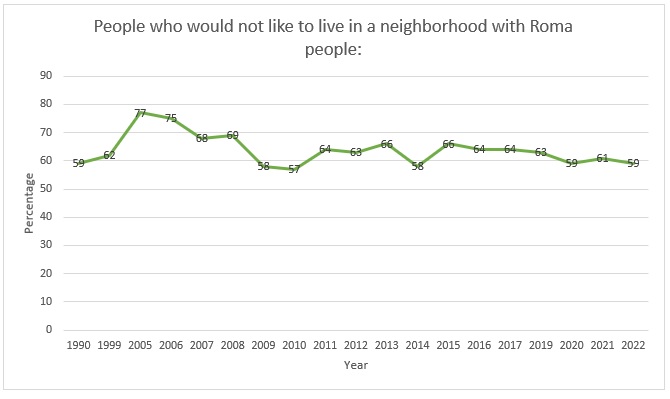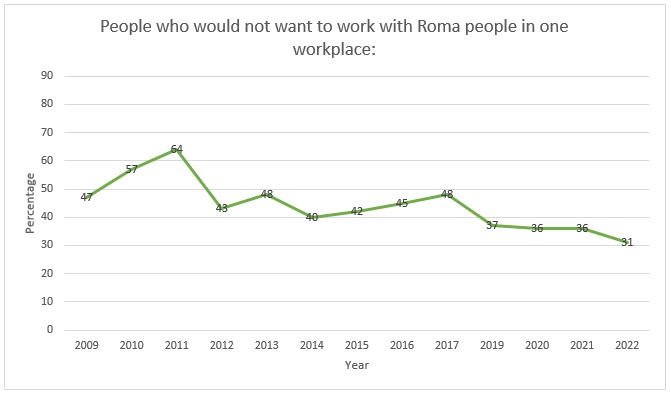The analysis of population survey results show that the negative attitudes of the Roma ethnic minority during the Independence period have remained high and have changed just slightly: the Roma was evaluated as the ethnic group with which Lithuanian population would not want to live in the neighborhood or work in the same workplace most.
Antigypsyism
Antigypsyism is the specific racism towards Roma and others who are stigmatized as “gypsies” in the public imagination. It is not a “minority issue” as well as the result of the poor living conditions many Roma have to live in, or the result of “how different they are”. It inverts cause and effect.
What sets antigypsyism apart is its high level of social acceptance. It is like a continuous headwind. “Roma inclusion” will remain illusory as long as we do not confront the headwind itself. There is as yet no commonly accepted definition of antigypsyism that finds wide acceptance in civil society, public institutions and academia. This recognition is a momentous step in the struggle for equal rights.
To formulate a working definition of antigypsyism that finds wide acceptance and makes the concept relevant for a broader group of decision makers should help create effective action to combat it. To acknowledge antigypsyism is to recognize the multifaceted character of the phenomenon and the common roots of discriminatory practices with widely varying forms and intensities. The arguments presented here favour the use of the term “antigypsyism” over terms like “anti-Romani racism” or “Romophobia”, which are sometimes proposed as synonymous.
Today’s antigypsyism has deep historical roots in our societies. It should be clearly understood that Romani people are not the cause of this ideology. The effects of historical discrimination and persecution do not end with the act itself, but continue to negatively affect the people. The basis of antigypsyism ideology is the presumption of fundamental differences between “them” and “us” which informs group construction processes and the designation of identities of those outside the group.
‘Antigypsyism’ has no relation to the actual people being stigmatized as ‘gypsies’ but presents a mirror image of our societies’ dominant norms: it pronounces how its members should not behave and thus acts to discipline them. Roma can be subjected to collective acts of discrimination such as hate speech, as well as institutional discrimination that reproduces existing patterns of disadvantage.
The institutions that are supposed to protect citizens from acts of discrimination and violence in practice all too often fail to extend the same level of protection to Roma as to non-Roma, exactly because of antigypsyism. To be labeled as the ‘other’ on a daily basis and having certain characteristics ascribed to you, has important socio-psychological effects. It is important to understand and accept that antigypsyism is not limited to right-wing extremism, but finds its way well into mainstream society and can be found among voters and representatives of any party.
What connects the intentionally malevolent and putatively benevolent forms of antigypsyism is their shared assumption that Romani people are fundamentally different and therefore need to be treated in a specific way and cannot be considered actors in their own right. Reactions are usually based on the assumption that either there is no problem, or that the marginalised people themselves are responsible for their situation.
The existing international and national monitoring structures need to be revisited in order to effectively document the complex manifestations of antigypsyism.
Antigypsyism refers to a specific form of racism: racism against people from Roma communities. It is very similar both in meaning, and in terms of its impact, to Romophobia, which describes fear, dislike or hatred of Roma people. It has been increasing in recent years, but the problem has old roots in Europe. For nearly a thousand years, the Roma in Europe have been stigmatised, abused, misunderstood, misjudged, excluded from society, denied the possibilities that others have been given, and blamed for many social ills. Such a history of injustice and discrimination, continuing to the present day, is a shameful indictment on European societies. It is bound to have left scars.
The problem of antigypsyism exists at different levels:
- It exists in people’s minds, at the level of attitudes, affecting the way that people think about Roma;
- It exist at the level of individual behaviour, shaping the way that people relate to and speak about Roma;
- It exist at the level of society as a whole, in the structures and policies which discriminate against the Roma.
The level of negative attitudes towards Roma:
- In the same year, 91% of Lithuanians said that they would be uncomfortable with a Roma neighbour;
- Opinion polls in other European countries have found that antigypsyism operates even in the absence of direct contact with the Roma.
The level of behaviour with Roma:
- On average – every second Roma respondent was discriminated against at least once in the previous 12 months;
- Roma who were discriminated against experienced on average 11 incidents of discrimination over a 12-month period;
- On average – 1 in 4 Roma respondents were victims of personal crime, including assaults, threats, serious harassment, at least once in the previous 12 months;
- On average – 1 in 5 Roma respondents were victims of racially motivated personal crime, including assaults, threats and serious harassment, at least once in the previous 12 months.
Our actions are usually affected by our attitude. It also affects ones who are affected by our behavior. Racist attitude directed against Roma often result in hatred and racist speech, and sometimes in even more harmful behavior such as physical violence.
Negative attitude towards the Roma affects their vulnerability. In some areas, Roma’s access to health services, full-fledged education and employment have decreased.
In certain countries, the negative attitude towards Roma is manifested due to the fact that not all Roma have identity documents, especially when registering children to study in schools. The lack of public transport or its funding, bullying, as well as the lack of learning tools, are the main obstacles for Roma children to pursue education.
The implemented policies and practices in the field of education often distinguish Roma children from other children – this is the conclusion reached by the Council of Europe. Education services currently remain inaccessible to Roma living in isolated communities, it might be either a remote village or a section of the city.

